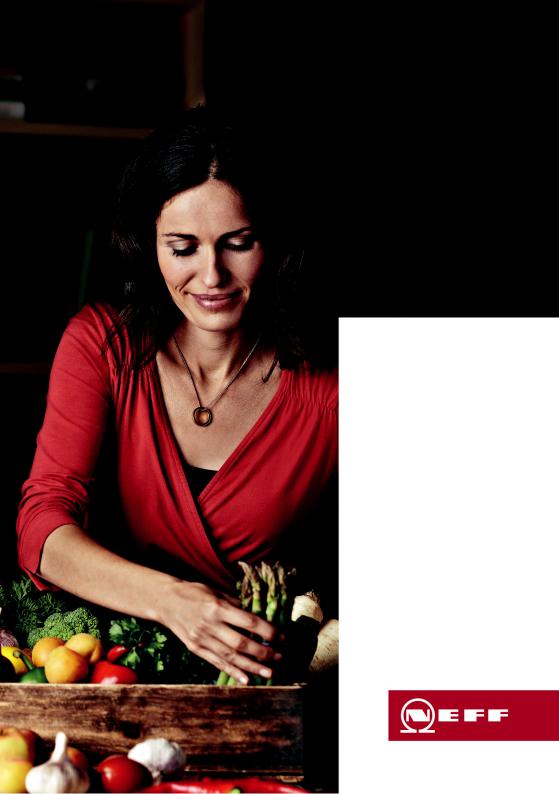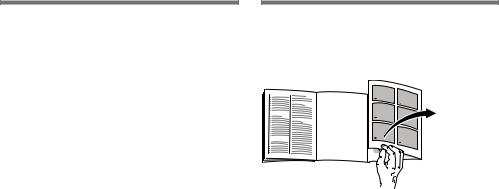Neff K8524X8GB User Manual

Fridge-freezer
en User manual
K420.. / K852..

en Table of Contents |
|
Safety and warning information ............ |
3 |
Information concerning disposal .......... |
5 |
Scope of delivery .................................... |
5 |
Installation location ................................. |
6 |
Room temperature, ventilation |
|
and cavity depth ...................................... |
6 |
Connecting the appliance ..................... |
7 |
Getting to know your appliance ........... |
7 |
Switching the appliance on ................... |
8 |
Setting the temperature ......................... |
8 |
Usable capacity ....................................... |
9 |
Refrigerator compartment ..................... |
9 |
Freezer compartment .......................... |
10 |
Max. freezing capacity ........................ |
10 |
Freezing and storing food .................. |
10 |
Freezing fresh food ............................. |
11 |
Super freezing ...................................... |
12 |
Thawing frozen food ............................ |
12 |
Interior fittings ....................................... |
12 |
Sticker “OK” .......................................... |
13 |
Switching off and disconnecting |
|
the appliance ........................................ |
13 |
Defrosting .............................................. |
13 |
Cleaning the appliance ....................... |
14 |
Tips for saving energy ........................ |
15 |
Operating noises ................................. |
15 |
Eliminating minor faults yourself ....... |
16 |
Customer service ................................. |
18 |

Safety and warning information
Before you switch ON the appliance
Please read the operating and installation instructions carefully! They contain important information on how to install, use and maintain the appliance.
The manufacturer is not liable if you fail to comply with the instructions and warnings. Retain all documents for subsequent use or for the next owner.
Technical safety
This appliance contains a small quantity of environmentally-friendly but flammable R600a refrigerant. Ensure that the tubing of the refrigerant circuit is not damaged during transportation and installation.
Leaking refrigerant may cause eye injuries or ignite.
If damage has occurred
■Keep naked flames and/or ignition sources away from the appliance,
■thoroughly ventilate the room for several minutes,
■switch off the appliance and pull out the mains plug,
■inform customer service.
The more refrigerant an appliance contains, the larger the room must be in which the appliance is situated. Leaking refrigerant can form a flammable gas-air mixture in rooms which are too small. The room must be at least 1 m³ per 8 g of refrigerant. The amount of refrigerant in your appliance is indicated on the rating plate inside the appliance.
en
If the power cord of this appliance is damaged, it must be replaced by the manufacturer, customer service or a similarly qualified person. Improper installations and repairs may put the user at considerable risk.
Repairs may be performed by the manufacturer, customer service or a similarly qualified person only.
Only original parts supplied by the manufacturer may be used. The manufacturer guarantees that only these parts satisfy the safety requirements.
A extension cable may be purchased from customer service only.
Important information when using the appliance
■Never use electrical appliances inside the appliance (e.g. heater, electric ice maker, etc.). Risk of explosion!
■Never use a steam cleaner to defrost or clean the appliance! The steam may penetrate electrical parts
and cause a short-circuit. Risk of electric shock!
■Do not use pointed or sharp-edged implements to remove frost or layers of ice. You could damage
the refrigerant tubing. Leaking refrigerant may ignite or cause eye injuries.
■Do not store products which contain flammable propellants (e.g. spray cans) or explosive substances
in the appliance. Risk of explosion!
■Do not stand or support yourself on the base, drawers or doors, etc.
3
en
■Before defrosting and cleaning
the appliance, pull out the mains plug or switch off the fuse.
Do not pull out the mains plug by tugging the cable.
■Bottles which contain a high percentage of alcohol must be sealed and stored in an upright position.
■Keep plastic parts and the door seal free of oil and grease. Otherwise, parts and door seal will become porous.
■Never cover or block the ventilation openings for the appliance.
■People (childern incl.) who have limited physical, sensory or mental abilities or inadequate knowledge must not use this appliance unless they are supervised or given meticulous instructions.
■Do not store bottled or canned drinks (especially carbonated drinks)
in the freezer compartment. Bottles and cans may explode!
■Never put frozen food straight from the freezer compartment into your mouth.
Risk of low-temperature burns!
■Avoid prolonged touching of frozen food, ice or the evaporator pipes, etc. Risk of low-temperature burns!
Children in the household
■Keep children away from packaging and its parts.
Danger of suffocation from folding cartons and plastic film!
■Do not allow children to play with the appliance!
■If the appliance features a lock: keep the key out of the reach of children!
General regulations
The appliance is suitable for cooling and freezing food.
This appliance is intended for use in the home and the home environment.
The appliance is suppressed according to EU Directive 2004/108/EC.
The refrigeration circuit has been checked for leaks.
This product complies with the relevant safety regulations for electrical appliances (EN 60335-2-24).
4

Information concerning disposal
* Disposal of packaging
The packaging protects your appliance from damage during transit. All utilised materials are environmentally safe and recyclable. Please help us by disposing of the packaging in an environmentally friendly manner.
Please ask your dealer or inquire at your local authority about current means of disposal.
* Disposal of your old appliance
Old appliances are not worthless rubbish! Valuable raw materials can be reclaimed by recycling old appliances.
according to the European guideline 2002/96/EC on waste electrical and electronic equipment – WEEE. The directive specifies the framework for an
EU-wide valid return and re-use of old appliances.This appliance is identified
ã=Warning
Redundant appliances
1.Pull out the mains plug.
2.Cut off the power cord and discard with the mains plug.
3.Do not take out the trays and receptacles: children are
therefore prevented from climbing in!
4.Do not allow children to play with the appliance once it has spent its useful life. Danger of suffocation!
en
Refrigerators contain refrigerant
and gases in the insulation. Refrigerant and gases must be disposed
of professionally. Ensure that tubing
of the refrigerant circuit is not damaged prior to proper disposal.
Scope of delivery
After unpacking all parts, check for any damage in transit.
If you have any complaints, please contact the dealer from whom you purchased the appliance or our customer service.
The delivery consists of the following parts:
■Built-in appliance
■Interior fittings (depending on model)
■Bag containing installation materials
■Operating instructions
■Installation manual
■Customer service booklet
■Warranty enclosure
■Information on the energy consumption and noises
5

en
Installation location
Install the appliance in a dry, well ventilated room. The installation location should neither be exposed to direct sunlight nor near a heat source, e. g.
a cooker, radiator, etc. If installation next to a heat source is unavoidable, use
a suitable insulating plate or observe the following minimum distances to a heat source:
■3 cm to electric or gas cookers.
■30 cm to an oil or coal-fired cooker.
Room temperature, ventilation and cavity depth
Ambient temperature
The appliance is designed for a specific climate class. Depending on the climate class, the appliance can be operated at the following temperatures.
The climate class can be found on the rating plate. Fig. *
Climate class |
Permitted ambient |
|
temperature |
SN |
+10 °C to 32 °C |
N |
+16 °C to 32 °C |
ST |
+16 °C to 38 °C |
T |
+16 °C to 43 °C |
Note
The appliance is fully functional within the room temperature limits
of the indicated climatic class. If an appliance of climatic class SN
is operated at colder room temperatures, the appliance will not be damaged up to a temperature of +5 °C.
Ventilation
The air on the rear panel of
the appliance heats up. Conduction of the heated air must not be obstructed. Otherwise, the refrigeration unit must work harder. This increases power consumption. Therefore: Never cover or block the ventilation openings!
Cavity depth
A cavity depth of 560 mm
is recommended for the appliance.
If the cavity depth is smaller – at least 550 mm – the energy consumption increases slightly.
6

Connecting the appliance
After installing the appliance, wait at least 1 hour until the appliance is switched on. During transportation the oil in
the compressor may have flowed into the refrigeration system.
Before switching on the appliance for the first time, clean the interior of
the appliance (see chapter “Cleaning the appliance”).
Electrical connection
The socket must be near the appliance and also freely accessible following installation of the appliance.
The appliance complies with the protection class I. Connect the appliance to 220–240 V/50 Hz alternating current via a correctly installed socket with protective conductor. The socket must be fused with a 10 to 16 A fuse.
For appliances operated in nonEuropean countries, check whether the stated voltage and current type match the values of your mains supply. This information can be found on the rating plate. Fig. *
ã=Warning
Never connect the appliance
to electronic energy saver plugs.
Our appliances can be used with mains and sine-controlled inverters. Mainscontrolled inverters are used
for photovoltaic systems which
are connected directly to the national grid. Sine-controlled inverters must be used for isolated applications (e.g. on ships or in mountain lodges) which are not connected directly to the national grid.
en
Getting to know your appliance
Please fold out the illustrated last page. These operating instructions refer
to several models.
The features of the models may vary. The diagrams may differ.
Fig. 1
ARefrigerator compartment
BFreezer compartment
1-4 Controls/light
5Light switch
6Glass shelf
7Vegetable container
8Frozen food container
9Door shelf
10Shelf for large bottles
7
